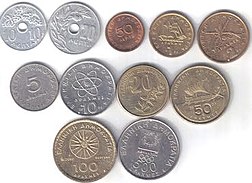Drachmas
| Drachma | |
|---|---|
| Δραχμή | |

Modern drachma coins
|
|
| ISO 4217 | |
| Code | GRD |
| Denominations | |
| Subunit | |
| 1/100 | leptοn (Λ.) |
| Symbol | Δρχ., Δρ. or ₯ |
| Banknotes | |
| Freq. used | 100, 200, 500, 1000, 5000, 10,000 Δρ. |
| Rarely used | 50 Δρ. |
| Coins | |
| Freq. used | 5, 10, 20, 50, 100, 500 Δρ. |
| Rarely used | 10 Λ., 20 Λ., 50 Λ., 1 and 2 Δρ. |
| Demographics | |
| User(s) | None, previously: Greece |
| Issuance | |
| Central bank | Bank of Greece and Greek mint |
| Website | www |
| Printer | Bank of Greece |
| Website | www |
| Mint | Bank of Greece |
| Website | www |
| Valuation | |
| Inflation | 3.1% (2000) |
| Source | Grecian.net |
| ERM | |
| Since | March 1998 |
| Fixed rate since | 19 June 2000 |
| Replaced by €, non cash | 1 January 2001 |
| Replaced by €, cash | 1 January 2002 |
| € = | 340.750 Δρ. |
|
This infobox shows the latest status before this currency was rendered obsolete.
|
|
Drachma (Greek: Modern Greek: [ðraxˈmi], Ancient Greek: [drakʰmέː]; pl. drachmae or drachmas) was the currency used in Greece during several periods in its history:
It was also a small unit of weight.
The name drachma is derived from the verb δράσσομαι (drássomai, "(I) grasp"). It is believed that the same word with the meaning of "handful" or "handle" is found in Linear B tablets of the Mycenean Pylos. Initially a drachma was a fistful (a "grasp") of six oboloí or obeloí (metal sticks, literally "spits") used as a form of currency as early as 1100 BC and being a form of "bullion": bronze, copper, or iron ingots denominated by weight. A hoard of over 150 rod-shaped obeloi was uncovered at Heraion of Argos in Peloponnese. Six of them are displayed at the Numismatic Museum of Athens.
It was the standard unit of silver coinage at most ancient Greek mints, and the name obol was used to describe a coin that was one-sixth of a drachma. The notion that drachma derived from the word for fistful was recorded by Herakleides of Pontos (387–312 BC) who was informed by the priests of Heraion that Pheidon, king of Argos, dedicated rod-shaped obeloi to Heraion. Similar information about Pheidon's obeloi was also recorded at the Parian Chronicle.
Ancient Greek coins normally had distinctive names in daily use. The Athenian tetradrachm was called owl, the Aeginetic stater was called chelone, the Corinthian stater was called hippos (horse) an so on. Each city would mint its own and have them stamped with recognizable symbols of the city, known as badge in numismatics, along with suitable inscriptions, and they would often be referred to either by the name of the city or of the image depicted. The exact exchange value of each was determined by the quantity and quality of the metal, which reflected on the reputation of each mint.
...
Wikipedia
